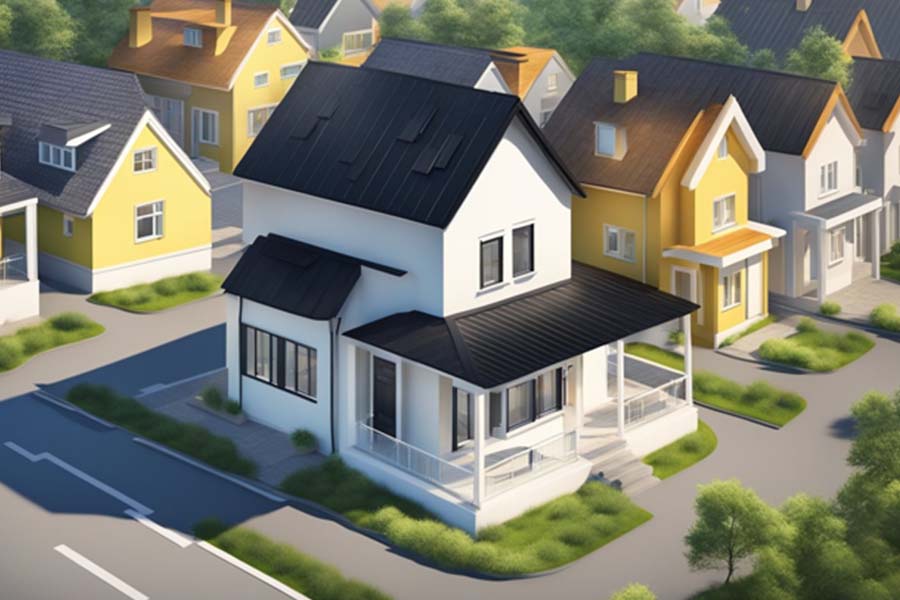Roof color may seem like a purely aesthetic choice, but it can actually have a significant impact on your home’s temperature and energy costs. The color of your roof can affect how much heat is absorbed by your home, which in turn affects how much you’ll spend on cooling and heating. In this article, we’ll explore how roof color affects your home’s temperature and energy costs, and what you can do to optimize your roof’s color for maximum efficiency.
The color of your roof can affect your home’s temperature in a few different ways. Darker colors, such as black or dark brown, absorb more heat from the sun than lighter colors, such as white or light gray. This means that a dark roof will make your home hotter in the summer, which can lead to higher cooling costs. On the other hand, a light-colored roof will reflect more sunlight and keep your home cooler, which can save you money on cooling. However, the optimal color for your roof will depend on a few different factors, such as your climate, the orientation of your home, and the type of roofing material you have.
The Science of Roof Color and Temperature Regulation
Solar Reflectance and Absorption
The color of a roof plays a significant role in determining the amount of solar energy that is absorbed or reflected by the roof. Darker colors such as black and dark brown tend to absorb more solar energy, while lighter colors such as white and light gray reflect more solar energy. This is because darker colors have a lower solar reflectance (the ability to reflect solar energy) and a higher solar absorptance (the ability to absorb solar energy) than lighter colors.
The amount of solar energy absorbed by a roof affects the temperature of the roof surface. When a roof absorbs more solar energy, it heats up, and this heat is transferred to the interior of the building. This can result in higher energy costs for cooling the building during hot weather.
Thermal Emittance
Another factor that affects the temperature of a roof is thermal emittance. This refers to the ability of a roof to radiate heat back into the atmosphere. Roofs with high thermal emittance can effectively release heat, which helps to keep the roof surface cooler.
The thermal emittance of a roof is influenced by several factors, including the color of the roof. Lighter colored roofs tend to have higher thermal emittance than darker colored roofs. This means that lighter colored roofs can effectively release more heat, which helps to keep the roof surface cooler.
In summary, the color of a roof can significantly impact the temperature of the roof surface and the energy costs associated with cooling a building. Darker colored roofs tend to absorb more solar energy and have lower thermal emittance, while lighter colored roofs reflect more solar energy and have higher thermal emittance. By choosing the right color for their roof, homeowners can help to regulate the temperature of their home and reduce their energy costs.
Comparing Roof Colors
Light vs. Dark Roof Colors
When it comes to choosing a roof color, homeowners often wonder whether a light or dark color is better. The answer is not straightforward, as both light and dark colors have their advantages and disadvantages.
Light-colored roofs, such as white or beige, reflect more sunlight than dark-colored roofs. This means that they absorb less heat and keep the house cooler in hot weather, which can reduce energy costs for air conditioning. However, light roofs may not be as effective in colder climates, where heat retention is more important.
Dark-colored roofs, such as black or dark brown, absorb more sunlight than light-colored roofs. This means that they retain more heat and keep the house warmer in cold weather, which can reduce energy costs for heating. However, dark roofs may not be as effective in hotter climates, where heat absorption can lead to higher energy costs for air conditioning.
Effects of Color on Different Materials
The color of a roof can also affect the temperature of the underlying materials. For example, asphalt shingles with a dark color can reach temperatures of up to 150°F on a hot day, while the temperature of light-colored asphalt shingles may only reach 90°F. This temperature difference can affect the lifespan of the roof and the material’s ability to withstand extreme weather conditions.
Metal roofs are also affected by color. Dark-colored metal roofs absorb more heat than light-colored metal roofs, which can lead to higher energy costs for air conditioning. However, metal roofs are more reflective than asphalt shingles, which means that even dark-colored metal roofs are more energy-efficient than dark-colored asphalt shingles.
Overall, the choice of roof color depends on various factors, such as climate, energy costs, and personal preference. Homeowners should consider the advantages and disadvantages of light and dark colors and choose a color that best suits their needs.
Energy Efficiency and Cost Implications
Impact on Cooling and Heating Costs
The color of your roof can impact your home’s cooling and heating costs. Darker colored roofs absorb more heat from the sun, which can increase the temperature inside your home. As a result, your air conditioning system will have to work harder to keep your home cool, leading to higher energy bills.
On the other hand, lighter colored roofs reflect more sunlight, which can help keep your home cooler. This means that your air conditioning system won’t have to work as hard, resulting in lower energy bills.
Long-Term Energy Savings
Choosing the right roof color can also help you save money on energy costs in the long run. By opting for a lighter colored roof, you can reduce your home’s cooling costs and save money on energy bills over time. In fact, studies have shown that homeowners can save up to 15% on cooling costs by choosing a lighter colored roof.
Additionally, a lighter colored roof can help extend the lifespan of your roof by reducing the amount of heat absorbed by your roof. This can help prevent damage from UV rays and other environmental factors, saving you money on roof repairs and replacement in the long run.
Overall, choosing the right roof color can have a significant impact on your home’s energy efficiency and cost savings. By considering the impact on cooling and heating costs and the potential for long-term energy savings, homeowners can make an informed decision when selecting a new roof color.
Roof Color and Climate Considerations
Best Roof Colors for Hot Climates
In hot climates, it is important to choose a roof color that reflects sunlight and heat, rather than absorbing it. Lighter colors such as white, beige, light gray, and light blue are ideal for hot climates as they reflect more sunlight and heat than darker colors. This means that less heat is transferred into the home, resulting in lower cooling costs.
Another option is to choose a metal roof with a reflective coating, which can reflect up to 70% of the sun’s rays. This can significantly reduce the amount of heat that enters the home, resulting in lower energy costs.
Best Roof Colors for Cold Climates
In cold climates, it is important to choose a roof color that absorbs sunlight and heat, rather than reflecting it. Darker colors such as black, dark gray, dark blue, and dark green are ideal for cold climates as they absorb more sunlight and heat than lighter colors. This means that more heat is transferred into the home, resulting in lower heating costs.
However, it is important to note that in areas with heavy snowfall, a darker roof may cause snow to melt more quickly, leading to ice dams and other issues. In these areas, a lighter roof color may be a better option.
Overall, when choosing a roof color, it is important to consider the climate of your area and the type of roofing material you plan to use. By choosing the right color and material, you can significantly reduce your home’s energy costs and improve its overall energy efficiency.
Material Considerations and Technological Advancements
Innovative Reflective Roof Materials
Reflective roof materials are designed to reflect sunlight and reduce the amount of heat absorbed by the roof. These materials come in a variety of colors and materials, including metal, asphalt, and tile. The most effective reflective materials are those that have a high solar reflectance and thermal emittance.
Metal roofs are a popular choice for reflective roofing due to their high solar reflectance and thermal emittance. They are available in a variety of colors and finishes, including light colors that reflect more sunlight. Asphalt shingles with reflective granules are also available and can reflect up to 30% of sunlight. Tile roofs can also be reflective, with light-colored tiles reflecting more sunlight than darker ones.
Emerging Roofing Technologies
New technologies are being developed to improve the energy efficiency of roofs. One such technology is cool roof coatings, which are designed to reflect sunlight and reduce the amount of heat absorbed by the roof. These coatings can be applied to existing roofs and are available in a variety of colors.
Another emerging technology is the use of phase change materials (PCMs) in roofing materials. PCMs are materials that can absorb and release heat, helping to regulate the temperature of the roof. When the temperature rises, the PCM absorbs heat, and when the temperature drops, it releases heat. This can help to reduce the amount of energy needed to cool a building.
Overall, there are many material considerations and technological advancements that can affect the energy efficiency of a roof. By choosing reflective materials and utilizing emerging technologies, homeowners can reduce their energy costs and help to mitigate the urban heat island effect.
Roof Color Selection Guide
Aesthetic and Architectural Factors
When choosing a roof color, it is important to consider the aesthetic and architectural factors of your home. The color of your roof can greatly impact the overall appearance of your home. For example, a light-colored roof can make your home appear larger, while a dark-colored roof can make it appear smaller. Additionally, the color of your roof should complement the other colors of your home, such as the siding, shutters, and front door.
Homeowners Association Guidelines
Before selecting a roof color, it is important to check with your homeowners association (HOA) for any guidelines or restrictions. Some HOAs have strict rules regarding the color and type of roofing materials that can be used in their communities. It is also important to consider the climate of your area when selecting a roof color. In warmer climates, lighter-colored roofs can help reflect sunlight and reduce cooling costs, while darker-colored roofs can absorb heat and increase energy costs.
Overall, choosing the right roof color can have a significant impact on your home’s temperature and energy costs. By considering aesthetic and architectural factors, as well as any HOA guidelines and climate considerations, homeowners can make an informed decision when selecting a roof color that best fits their needs.





0 Comments